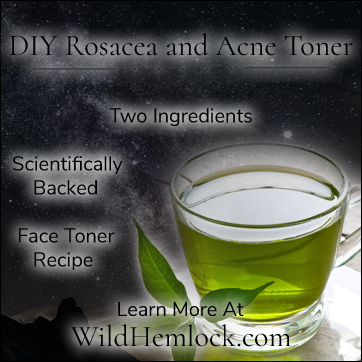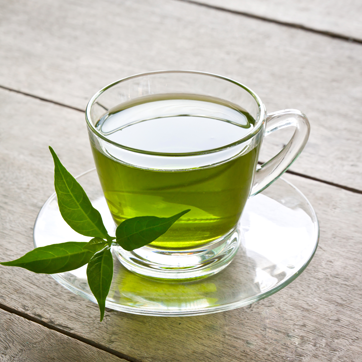Disclaimer: I am not a medical professional. Do not ingest or otherwise use a herb or oil based on this information. Always do your own research, and speak with a medical professional about the supplements that you are taking. Wild Hemlock takes no responsibility of how you use this information. Herbs on this website may not be approved by the FDA nor may be on the Generally Regarded as Safe list of herbs maintained by the FDA. This information has not been evaluated by the FDA. This information is not intended to diagnose, treat, cure, or prevent any disease.

Like many people, especially those with autoimmune disease, I suffer from rosacea and acne. Although I had hoped that I would eventually grow out of my skin problems after my teenage years, it appears that the acne is still going strong. As tempting as it is to buy a bottle of wonder drug skin care at the store, most store-bought products stop working after a few months – at least for me. Perhaps I am cursed, I have the same problem with allergy pills!
Plenty of blogs out there espouse hundreds of botanical cure-alls, which have the same amount of chance to fix your skin as to ruin it. For example, lemon juice is not the greatest skin product[8]. Despite all of the well-intentioned yet mostly incorrect blogs out there, there is definitely some very beneficial botanical remedies that work. Scientists study these plants and conduct trials and meta-studies all the time. These studies don’t often make the news or make millions of dollars for skin care companies, but they do exist out there.
In search for an tool to aid my quest against rosacea and acne, researched through these aforementioned blogs to find verifiable acne solutions. First, I found the active ingredients. Next, I researched these active ingredients. Then, I selected the ingredients most likely to achieve my goals. Lastly, I created a prototype product to test on myself. After that, I modified my prototype recipe and repeated the cycle again. This is the result!
- 1 oz Witch Hazel Astringent/Antiseptic
- 1 oz strong Green Tea
Instructions:
- Select your green tea bag. The green tea should be unflavored and contain no other ingredients besides camellia sinensis.*
- Boil purified water.
- Steep green tea bag for 10 minutes in boiled water.
- In clean container, mix 1 oz green tea and 1 oz witch hazel astringent.
- Shake to combine. Allow to cool with lid on.
Suggested Use:
- Shake well before use
- Place 5 – 10 drops on a cotton ball, empty wipe, or reusable wipe
- Wipe all over face, specifically the nose, T-Zone, and areas which acne propegates
- After drying, moisturize with a high quality face lotion
- Do not use more than once per day
- Do not use with other harsh products
This is the result of two iterations of product development and testing. This is the simplest version I have created and so far the most effective. It is important to remember that “n=1” of this experiment – that means that your skin may react differently! Due to this, it is extremely important to patch test all new skin care products and ensure you do not have an allergic reaction.
The websites that demand customers to stop using cheap, easily accessible witch hazel are also the ones which encourage them to use witch hazel in their formulations. Hmm, I wonder what the motive might be?
The second ingredient I removed during this process was essential oils. There are many which can help acne (in correct dosages and delivery methods), but I found that the oils did not mix well. Almost all of the oils were used up in the first few uses, leaving the rest of the bottle without these active ingredients. If I wanted essential oils and water-based ingredients to properly mix, I would have had to have added an emulsifier, but that would have made the end product more like a serum than a toner.
The two ingredients, witch hazel and green tea, are powerful anti-acne and anti-rosacea medicines. They perform three functions in this formulation: an astringent, an acne treatment, and an anti-inflammatory. Additionally, the green tea in this recipe is slightly alkaline [9], which counter balances the acidic pH of witch hazel [10] to make it gentler on your skin.
An astringent is a product which cleanses the skin of residue leftover from makeup and cleansers, remove excess sebaceous excretions (face oils), and provide a mild exfoliation among other uses [5]. Additionally, and significantly, astringent toners have the ability to temporarily shrink pores [4]. This action is useful for oily, combination, and acne-prone skin. Astringents reduce the occurrence of acne by lowering the amount of sebum in which the acne can live and preventing acne-causing bacteria from entering the pores in the first place [5].
Witch hazel, or hamamelis virginiana, is a potent astringent [5]. It has been used in cosmetic applications for its astringency for at least a hundred years, if not more [4]. Witch hazel is a hydrosol or extract consisting of the plant’s twigs, bark, and leaves. It is commonly used as a source of tannins in many different acne and cosmetic products [5]. In addition to its astringency, it is also known to be high in antioxidants [1]. Witch hazel also possesses an anti-bacterial effect, which contributes to its ability to fight acne [2].
Warning! While astringents reduce oil secretion and help with acne, there may be side effects which appear over long term use. Astringents, especially those with alcohol such as most witch hazel you can buy, dry the skin. When the skin dries, it secretes more sebum in order to hydrate itself. Over time, this may eventually lead to skin becoming overly oily or overly dry. Secondly, prolonged use of alcohol may make skin more sensitive [3]. While this is important to consider, it can be remedied with proper hydration and moisturizing after use. The websites that demand customers to stop using cheap, easily accessible witch hazel are also the ones which encourage them to use witch hazel in their formulations. Hmm, I wonder what the motive might be?
To avoid the alcohol, I did some research into “alcohol free” witch hazel. Almost all of it used witch hazel extract instead of hydrosol. Guess what those witch hazel extracts used? Alcohol! Perhaps you can reduce the amount of alcohol if you are particularly sensitive, but it is difficult to remove it completely.
Green Tea, or camellia sinensis, has many medical benefits attributed to it, but today we are looking for its anti-inflammatory and anti-acne effects. Green tea is up to 30% flavanols and catechins, which have been shown to be active anti-inflammatories and antioxidants [2]. (In fact, the study I just cited was specifically about tea, witch hazel, and rose’s effect on skin! #2 below) These anti-inflammatories show that they are effective against rosacea specifically [6]. Additionally, green tea has anti-microbial and anti-lipogenic (the generation of sebum lipids or facial oils) properties which enhance its anti-acne abilities [7]. Green tea is contains between 2 and 11% Vitamin C, depending on its species [11]. Vitamin C has many benefits, including fighting acne [12].
I have found that these two products together have the best efficacy of all the recipes I’ve tried, and my acne is starting to come under control. There are many other herbs and plants that replace store-bought products, so stay tuned for more!
* I find that middle-tier quality green tea is the perfect balance of quality and cost. I would not spend more than $3-5 per box at the grocery store.
Sources:
- Chularojanamontri, Leena et al. “Moisturizers for Acne: What are their Constituents?.” The Journal of clinical and aesthetic dermatology vol. 7,5 (2014): 36-44. <https://www.ncbi.nlm.nih.gov/pmc/articles/PMC4025519/>
- Thring, Tamsyn Sa et al. “Antioxidant and potential anti-inflammatory activity of extracts and formulations of white tea, rose, and witch hazel on primary human dermal fibroblast cells.” Journal of inflammation (London, England) vol. 8,1 27. 13 Oct. 2011, doi:10.1186/1476-9255-8-27 <https://www.ncbi.nlm.nih.gov/pmc/articles/PMC3214789/>
- “Why Witch Hazel Is a Problem for Skin.” Paula’s Choice. <https://www.paulaschoice.com/expert-advice/skincare-advice/natural-skincare/is-witch-hazel-good-for-skin.html>
- Mahmood, N.f., and A.r. Shipman. “The Age-Old Problem of Acne.” International Journal of Women’s Dermatology, vol. 3, no. 2, 2 Dec. 2016, pp. 71–76., doi:10.1016/j.ijwd.2016.11.002. <https://doi.org/10.1016/j.ijwd.2016.11.002>
- Baran, R., and Howard I. Maibach. Textbook of Cosmetic Dermatology. 2nd ed., Taylor & Francis, 2005. <https://books.google.com/books?id=yIVfq5Lpl2EC>
- Emer, J., Waldorf, H., & Berson, D. (2011, September). “Botanicals and anti-inflammatories: natural ingredients for rosacea”. In Seminars in cutaneous medicine and surgery (Vol. 30, No. 3, pp. 148-155). WB Saunders. <https://mdedge-files-live.s3.us-east-2.amazonaws.com/files/s3fs-public/issues/articles/Vol30_i3_Emer.pdf> Warning, PDF!
- Saric, Suzana et al. “Green Tea and Other Tea Polyphenols: Effects on Sebum Production and Acne Vulgaris.” Antioxidants (Basel, Switzerland) vol. 6,1 2. 29 Dec. 2016, doi:10.3390/antiox6010002 <https://www.ncbi.nlm.nih.gov/pmc/articles/PMC5384166/>
- Dr. Taha, Hanan. “How PH Affects the Skin.” FutureDerm, 9 Oct. 2017, <https://www.futurederm.com/how-ph-affects-the-skin/>
- Brusie, Chaunie. “Is Tea Acidic? Know the Facts.” Healthline, Healthline Media, 11 Oct. 2017 <https://www.healthline.com/health/food-nutrition/is-tea-acidic>
- Phelan, Michele, and L.e. “Witch Hazel.” Dermascope, DERMASCOPE Magazine. <https://www.dermascope.com/resources/witch-hazel>
- “Vitamin C Content of Tea.” RateTea.com, 6 Nov. 2014. <https://www.ratetea.com/topic/vitamin-c-tea/62/>
- Woolery‐Lloyd, H., Baumann, L. and Ikeno, H. (2010), “Sodium L‐ascorbyl‐2‐phosphate 5% lotion for the treatment of acne vulgaris: a randomized, double‐blind, controlled trial.” Journal of Cosmetic Dermatology, 9: 22-27. doi:10.1111/j.1473-2165.2010.00480.x <https://onlinelibrary.wiley.com/doi/abs/10.1111/j.1473-2165.2010.00480.x>

